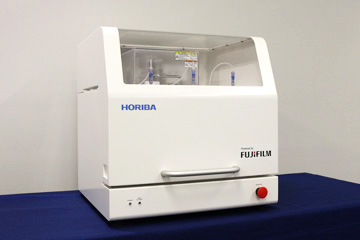-- FUJIFILM Corporation (President and CEO, Representative Director: Teiichi Goto) and HORIBA, Ltd. (President: Masayuki Adachi) today announced the co-development of a novel gene delivery system that significantly enhances productivity in the manufacture of gene therapy products. Fujifilm has developed the industry’s first*1 continuous electroporation technology*2, which enables high-efficiency gene delivery into cells during the manufacturing process for gene therapy products, boosting productivity by approximately 100 times*3 greater compared to conventional methods. HORIBA played a key role in integrating this technology into a system and plans to release the finalized device to the global market in 2026 or later.
Gene therapy is an approach that uses biotechnology to introduce functional genes into the body, targeting the root cause of genetic disorders. This technology is attracting global attention for its potential in treating intractable diseases that currently lack effective treatment options. Although the global cell and gene therapy market is projected to grow at a compound annual growth rate of approximately 30% through to 2030*4, several challenges remain. These include overcoming the technological complexities and inefficiencies of current manufacturing processes as well as high costs associated with research and development.
To address these challenges, Fujifilm and HORIBA, two companies with extensive expertise in the life sciences field, joined forces to develop a gene delivery system designed to enhance manufacturing productivity and reduce costs. The development process leveraged Fujifilm’s advanced technologies and process control expertise, honed across a broad range of business fields including biopharmaceuticals, while HORIBA contributed its extensive manufacturing expertise and global support capabilities for industrial applications to oversee the design and production of the system. Following its commercial launch, HORIBA will lead sales and support efforts, focusing on the North American and European markets, where demand for the gene therapy is particularly high.
By combining their respective strengths to develop and roll out this system, Fujifilm and HORIBA aim to help solve the pressing societal challenge of unmet medical needs.
Background of the Co-Development Project
Fujifilm and HORIBA have a history of collaboration across a variety of fields, including bioscience and semiconductors. The two companies have previously engaged in joint research, including those using HORIBA’s sensor technologies to improve the efficiency of pharmaceutical production processes. In 2023, the two companies launched a joint project to develop a gene delivery system (continuous electroporation system) in order to address production challenges in the growing field of gene therapy products.

The Continuous Electroporation System
Overview of the Continuous Electroporation System
In the manufacture of gene therapy products, which involves the introduction of genes into cultured cells, improving the efficiency of the gene delivery process is key to increasing overall productivity. The conventional method, which relies on chemical reactions transfection reagent, faces efficiency challenges due to the complex chemical reactions involved and the difficulty in controlling the interactions between cells and reagents. Fujifilm’s innovative continuous electroporation technology, which was utilized in the project, address these limitations. By applying precisely controlled electrical pulses to cell membranes, it creates minute pores that allow genes to be directly delivered into the cells, significantly enhancing gene delivery efficiency. Furthermore, the system operates in a continuous flow, offering flexibly to adjust throughput and handle production on both small to large-scale. Compared to conventional batch-based methods, this continuous electroporation system can achieve up to 100 times greater productivity, contributing substantially to both manufacturing efficiency and cost reduction in gene therapy production.
Conventional Method

Gene delivery performed using PEI*5 as a chemical transfection reagent
Fujifilm’s Continuous Electroporation Technology

Cells suspended in liquid are continuously passed through an electroporation unit where electrical pulses are applied, creating pores in the cell membranes via which genes can be injected directly
Comment from Toshihisa Iida, Director, Corporate Vice President, General Manager of Life Sciences Strategy Headquarters
At Fujifilm, we are dedicated to supporting pharmaceutical companies and patients through integrated solutions across the drug development lifecycle, guided by our "Partners for Life" principle. The implementation of continuous electroporation technology marks a major step forward, improving gene delivery efficiency while addressing manufacturing cost challenges. By combining Fujifilm's advanced technologies with Horiba's manufacturing expertise, we aim to create a future where gene therapy drugs are accessible to more patients. Through continuous innovation, we strive to advance healthcare and improve the well-being of people around the world.
Comment from Masayuki Adachi, President of HORIBA
I am delighted that we have succeeded in developing a continuous electroporation system based on Fujifilm’s outstanding technology. The Bio & Healthcare field is essential to future growth, and going forward we will leverage our strength in analytical and measurement technologies, data management capabilities, and global support infrastructure, which we have cultivated in high-volume manufacturing fields such as automotive products and semiconductors, to accelerate the commercialization of this system, thereby contributing to better health and quality of life for many people.
- *1 Based on research conducted by Fujifilm.
- *2 A technology that uses controlled electrical pulses to create minute pores in cell membranes, allowing genes to be directly delivered into cells. This enables high-efficiency gene delivery and is anticipated to enhance productivity while reducing costs in the manufacture of gene therapy products. This technology was presented at the 26th Annual Meeting of the American Society of Gene & Cell Therapy held in Los Angeles, U.S., in 2023.
- *3 Based on internal studies by Fujifilm. Compared to conventional chemical transfection using PEI reagents (as of August 7th, 2025).
- *4 Estimate by Fujifilm based on data provided by Evaluate Pharma®, January 2025.
- *5 PEI: Polyethylenimine, a type of polymeric material used as a reagent for delivering genes or proteins into cells.

- * Please note that the contents including the product availability, specification, prices and contacts in this website are current as of the date of the press announcement and may be subject to change without prior notice.
Release ID: 89167236




 Google
Google RSS
RSS